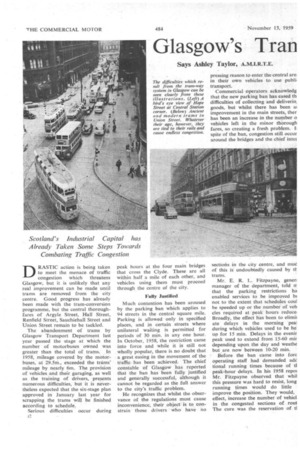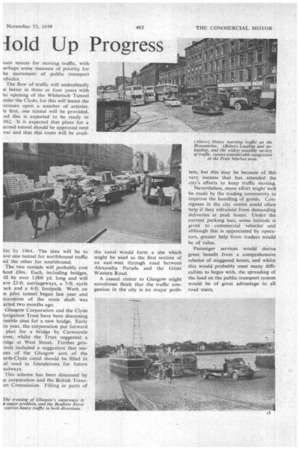Glasgow's Tran
Page 124

Page 125

If you've noticed an error in this article please click here to report it so we can fix it.
Told Up Progress Says Ashley Taylor, A.M.I.R.T.E.
DRASTIC action is being taken to meet the menace of traffic congestion which threatens Glasgow, but it is unlikely that any real improvement can be made until trams are removed from the city centre. Good progress has already been made with the tram-conversion programme, but the central thoroughfares of Argyle Street, Hall Street, Renfield Street, Sauchiehall Street and Union Street remain to be tackled.
The abandonment of trams by Glasgow Transport Department last year passed the stage at which the number of motorbuses owned was greater than the total of trams. In 1958, mileage covered by the motorbuses, at 29.5m., exceeded the trams' mileage by nearly 6m. The provision of vehicles and their garaging, as well as the training of drivers, presents numerous difficulties, but it is nevertheless expected that the six-stage plan approved in January last year for scrapping the trams will be finished according to schedule.
Serious difficulties occur during J2 peak hours at the four main bridges that cross the Clyde. These are all within half a mile of each other, and vehicles using them must proceed through the centre of the city.
Fully Justified Much contention has been aroused by the parking ban which applies to 94 streets in the central square mile. Parking is allowed only in specified places, and in certain streets where unilateral waiting is permitted for periods of 30 min. in any one hour. In October, 1958, the restriction came into force and while it is still not wholly popular, there is no doubt that a great easing in the movement of the traffic has been achieved. The chief constable of Glasgow has reported that the ban has been fully justified and generally successful, although it cannot be regarded as the full answer to the city's traffic problem.
He recognizes that whilst the observance of the regulations must cause inconvenience, their object is to• constrain those drivers who have no
pressing reason to enter the central are; in their own vehicles to use publi. transport.
Commercial operators acknowledg that the new parking ban has eased th difficulties of collecting and deliverin, goods, but whilst there has been al improvement in the main streets, them has been an increase in the number o vehicles left in the minor thorough fares, so creating a fresh problem. Ii spite of the ban, congestion still occur around the bridges and the chief intet
sections in the city centre, and muc of this is undoubtedly caused by tltrams.
Mr. E. R. L. Fitzpayne, gener; manager of the department, told if that the parking restrictions ha enabled services to be improved bi not to the extent that schedules coul be speeded up or the number of veh des required at peak hours reduce. Broadly, the effect has been to elimit ate delays in the morning peal during which vehicles used to be he up for 15 min. Delays in the evenir peak used to extend from 15-60 mir depending upon the day and weathe but are now between 10-20 min.
Before the ban came into fore operating staff had demanded ack tional running times because of ti peak-hour delays. In his 1958 repo] Mr. Fitzpayne observed that whil this pressure was hard to resist, long running times would do little improve the position. They would, effect, increase the number of vehicl in the congested sections of rout The cure was the reservation of tl nain streets for moving traffic, with ■ erhaps some measure of priority for he movement of public transport rehicles.
The flow of traffic will undoubtedly ie better in three or four years with he opening of the Whiteinch Tunnel alder the Clyde, for this will lessen the Iressure upon a number of arteries. Ikt. first, one tunnel will be provided, ad this is expected to be ready in 962. It is expected that plans for a econd tunnel should be approved next ear and that this route will be avail ble by 1964. The idea will be to ave one tunnel for northbound traffic nd the other for southbound.
The two tunnels will probably cost bout £9m. Each, including bridges, be over 1,000 yd. long and will ave 22-ft. carriageways, a 7-ft. cycle .ack and a 4-ft. footpath. Work on ie pilot tunnel began last year and (cavation of the main shaft was arted two months ago.
Glasgow Corporation and the Clyde lavigation Trust have been discussing ossible sites for a new bridge. Early tis year, the corporation put forward plan for a bridge by Carnoustie treet, whilst the Trust suggested a ridge at West Street. Further _proasals included a suggestion that secons of the Glasgow arm of the orth-Clyde canal should be filled in 2d used as foundations for future )adways.
This scheme has been discussed by te corporation and the British Trans3rt Commission. Filling in parts of the canal would form a site which might be used as the first section of an east-west through road between Alexandra Parade and the Great Western Road.
A casual visitor to Glasgow might sometimes think that the traffic congestion in the city is no major prob lem, but this may be because of this very success that has attended the city's efforts to keep traffic moving.
Nevertheless, more effort might well be made by the trading community to improve the handling of goods. Consignees in the city centre could often help if they refrained from demanding deliveries at peak hours. Under the current parking ban, some latitude is given to commercial vehicles and although this is appreciated by operators, greater help from traders would be of value.
Passenger services would derive great benefit from a comprehensive scheme of staggered hours, and whilst this would probably meet many difficulties to begin with, the spreading of the load on the public transport system would be of great advantage to all road users.
































































































































































































































































